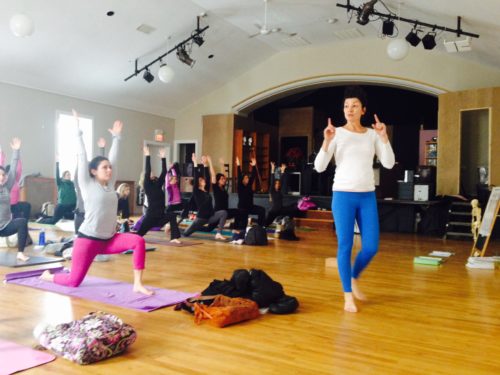
I read a hilarious post today by one of my teaching colleagues which mentioned the cue that we sometimes hear in class that goes something like this, ” Rest in Downward Dog for a moment.” I must admit, I’ve said something along those lines a few times. It’s kind of an old school cue; one that conjures up images of a practiced yogi for whom a challenging (yes, indeed) pose like Downward Dog is in fact one where he or she can find rest.
I got a chuckle out of it. But onto more serious things. The skill of providing helpful and actionable yoga cues while teaching is obviously a critical one. Regardless of how many students you have in class, your main way of communicating with them is through your voice and the words you use. Even if you do some of the poses with them, the main way you’re sharing with them what they need to do is with what you say. Now, I know some of you out there are possibly practicing the entire sequence with your students and that’s a topic for a different conversation ( I think that’d make an interesting blog post, actually) but that’s not the scenario we’re discussing here. In this post, we’re talking about what makes for a good cue in yoga teaching?
Actionable: Yoga cues should primarily focus on what the student has to DO. Not what they should feel or a suggested feeling they might have or something that has no relationship at all to what they’re to be doing. It should almost always be focused on what they need to do in order to create the pose at hand. Words that fall into this category are things like: root, press, squeeze, push, lift, reach, set, hug in, draw in, lift, relax and spread.
Generally understandable: Because my teaching is anatomically based, I have to be careful with this tip because I can go deep into the weeds in terms of the details associated with my cues. I don’t, of course, but I could. Even referring to “sitting bones” can be misconstrued because many students won’t know where they are located. So, it’s important that your cues are generally understandable. Examples of this might include: Spread your fingers wide, hug your thighs close, reach your arms to the sky, set your eyes, press your feet flat, stretch across the chest, press the floor away, press into the floor, draw the inner edges of the feet closer, stack your joints. You get the idea.
As brief and as easily digestible as possible: People are coming to yoga and their head is full of the details of their life. They often don’t have a huge attention span and a lot of extra time or mental space to hear a 10 point action plan for coming into a pose. So, the shorter you can make the statement, the better. I usually speak my cues in chunks of words, almost like a poem. So something like, “Step your right foot forward. Root your back heel. Reach up.” I pause briefly between each statement and then pause at the end of the 3 statements. Can you guess what pose this describes? Warrior 1.
Related to the physical body as much as possible. I used to teach a great deal to the head. Meaning, I’d provide empowerment phrases (things like, “You’re stronger than you think!” ” Come out of your head and into your body!”) but I’ve pretty much given all that up now. I speak to the physical. I might provide a bit of cueing or more conversational talk around meditative qualities of some of the poses, or taking a moment to become more present but I rarely go into anything that involves state of mind. I figure the best way to give my students a clearer state of mind is through the physical. That’s just my thing. You may like to speak on yoga philosophy or classical yoga stories; maybe your way is indeed to be a wellness coach and yoga teacher. I’m not saying that’s wrong. I’m just saying that’s not my style. But in any event, even in those cases, when it comes to cues, the more physical they can be, often the better. In the examples I gave above, this relates to what I’m referring to in terms of physical cues.
Anticipate or speak to actual problems happening in the room. The whole reason for not practicing while you teach is so that you can see what’s not working with your verbal cues and say something different to help your students out. So, for instance, if you see that a number of students are depressing their shoulder blades while reaching their arms up in Warrior 1 (an old school thing that we used to actually teach) you can say something like, “Let your shoulder blades ride up. They’re designed to do that when you lift your arms.” Â If you notice a number of student pulling their heels back really close to their hips in Bridge, you can speak to that. If you see a number of students hyperextending their knees in Downward Dog, you can speak to that. If you anticipate some challenges people might have ( like sinking into the hands in Downward Dog) you can speak to it even without seeing it happen. That’s what I meant by “anticipating” a problem and bringing it up in advance.
These are general tips but can be a starting point if you’re a new teacher and feeling a bit overwhelmed by the concept of cueing in yoga.
If you’re looking for more anatomy based information, you might like my free download here:
Interested in receiving a 3-PDF Teacher’s Yoga Anatomy Kit? Click here!
